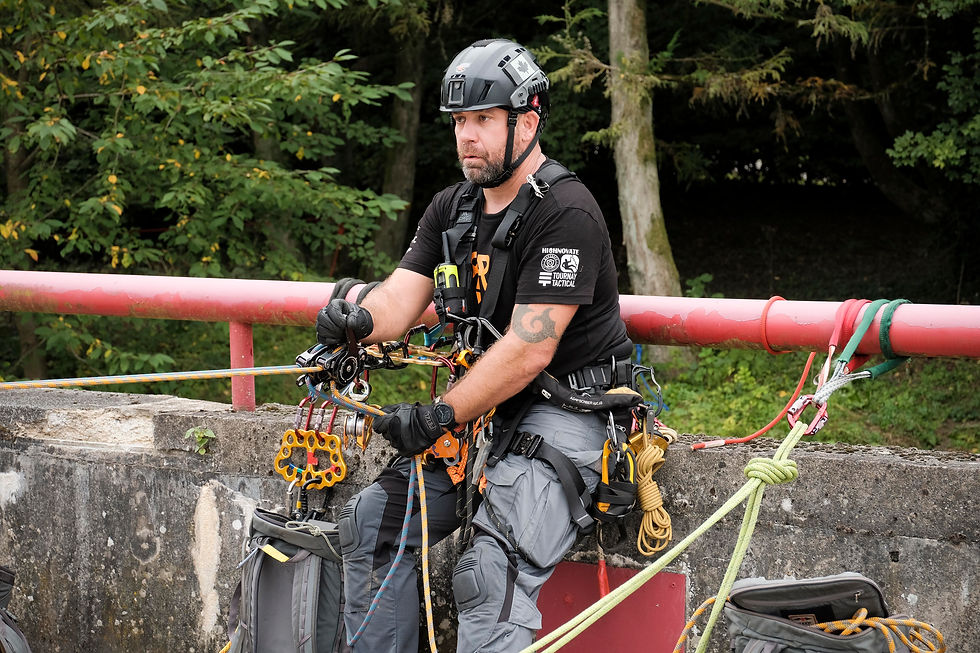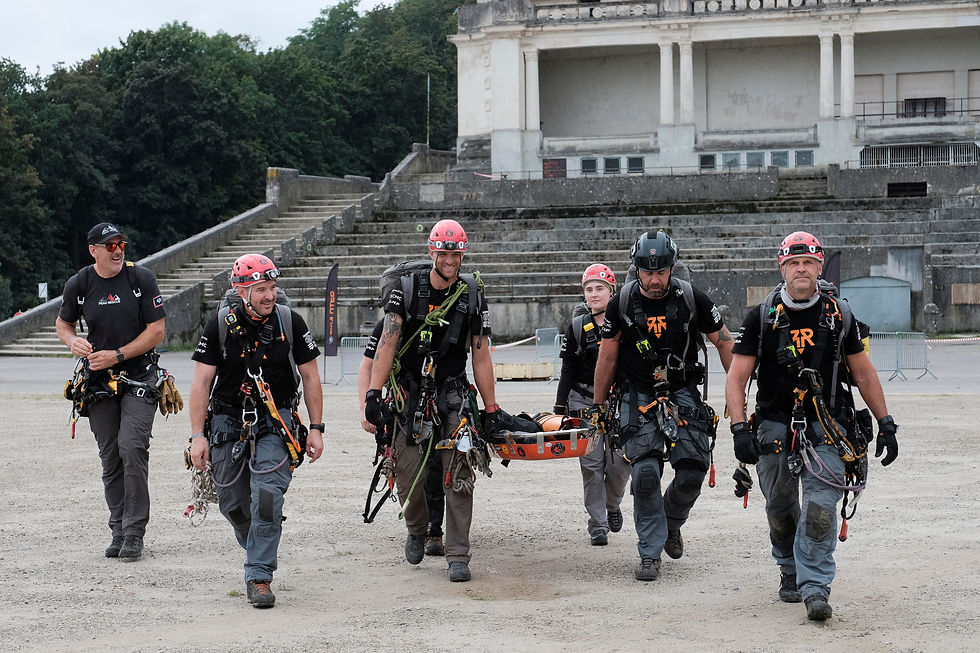A first-time GRIMP experience
- Ronin Rescue

- Dec 22, 2021
- 4 min read
We all know about it. The 'Olympics of Rescue'. The one that started it all. A place of triumph and tribulations; comedy and tragedy; beer and wine; ropes and hardware........yes, I'm talking about GRIMPDAY Namur.

This year was my first experience at GRIMP. Ronin prides itself on a continuous line of participation dating back to 2013 (with the exception of 2020 due to COVID) and it's considered a rite of passage for all of our top tier instructors, not just for the training and experiential value, but the added value of the networks built and strengthened at GRIMP.
Ronin's 2021 team had, for the most part, volunteered the year before, before COVID shut down the event. I was set to lead the GRIMP Japan team, which was to be held in Okinawa in the fall of 2020. However, due to the cancellations, we all then volunteered for this GRIMP. This meant a commitment in late 2020 to undertake your own training over the year in preparation.
I'd love to say we had a rigorous and challenging team training cycle, but with members spread across Canada, and therefore the breadth of the North American continent, getting together to train wasn't an option. Never mind the fact we were all busy with our day jobs, as well as the rush to conduct training for clients that had been cancelled/postponed the year before! So, in the end, we had to conduct our own training on our own time, and hope to meld it together as a team in Belgium by arriving a few days early and getting some training days in.
Now, the GRIMP format, for those who haven't been, is as follows: Each team has 1 Team Lead, 4 Team Members, 1 patient, and 1 observer. They then, over 3 days, conduct a shotgun start to various stands where rescue scenarios are to be completed. Note: they don't always include rope! So with the 2021 edition beginning on a Thursday, we all flew into Belgium and met up in Namur on the previous Sunday.
In theory, we were given a day to recover from jet lag, but in practice, this involved a not-altogether-welcome walking tour of Namur and likely scenario locations, which inevitably devolved into story-hour. If it's not obvious the jet lag hit me hard, well, then I don't know what to say!
We trained for a couple of days in the local area, namely a climbing area just on the outskirts of Namur called 'Les Rochers Grande-Malades' or Big Sick Rocks, named so due to their usage as a leper colony in the Middle Ages. Even with so little time, we managed to coalesce as a team and get some drills nailed down – but more on that later. We also trained at Fort De Dave, a Brialmont fort that defended Namur in both World War I and World War II. One could make mention of the awkwardness encountered when one of our team asked ‘Who was the fort supposed to defend against?’…..as the German team practiced nearby, but that would be somewhat tasteless. So I shan’t.

Now I could go on about the competition itself, the registration, kit inspection, the scenarios, etc, etc. All that can be found online, and I’d only be repeating what others have said. So instead, I’ll share my observations as a GRIMPDAY virgin, a first-timer, in particular, the lessons learned in regards to rescue:
1. Simplicity: as every event was partially scored on time, the simpler you can rig, the better. There is a tendency amongst rope professionals to rig complex systems just for the sake of doing so, especially when training rescue technicians. However, in a real-life situation, the critical factor is time. The patient is inaccessible without rope systems, otherwise, they would already be in medical care. The quicker we get them to medical care, the better the outcome. As well, for training’s sake, why try and be ok at 75 tasks, when we can better use our time to nail down 25 tasks to perfection? In other words…KISS (Keep It Simple Stupid)
2. Training – train your team with ‘mission command’ in mind. Those veterans amongst you dear readers will know what I mean, but to the uninitiated, Mission Command is “a style of military command which combines centralised intent with decentralised execution”. In other words, tell your team what you want to happen and let them execute with minimal interference from you. As a ‘rigger’ my responsibility was the rigging of whatever rope system was required for the task. Apart from a safety check, the TL had zero input on how I anchored, what I anchored to, or what system I rigged, as long as it achieved the ‘intent’.
3. Adaptability – it’s easy for us as rescuers to simply be given a scenario, plan our response to it and get ‘tunnel vision’… but we need plan B, Plan C, and Plan D constantly ready and waiting in our minds. Moreover, we need to train where plan A doesn’t work.
4. Fitness – This, I cannot stress enough. Whilst there will be some who say ‘we are building rope systems, not running marathons, the simple fact of the matter is, the fitter you are, the less tired you will get, and the better decisions you’ll make. This is proven across many different fields, not just rope rescue. As to what type of fitness, well: Cardiovascular – this year's GRIMP included a hell of a lot of walking, the better your CV fitness the less gassed you’ll be showing up to a scenario; upper body fitness – one event had us manually carry a stretcher and patient through an aerial obstacle course (not on rope) and so we needed to conduct a ton of low arm carries, lifts, holds and pushes, using our entire body mostly (imagine cleaning and jerking a loaded basket stretcher up through a hole in the floor). But in short – fitness, fitness, fitness.
In closing, I’d recommend the GRIMPDAY competition for any rope rescue professional. It’s a physical, mental, and sometimes emotional challenge without comparison to anything we do in our normal lines of work. Remember the ‘Firefighter Combat Challenge”? 2-minute event. This is 3 days.
Do it. You won’t be disappointed.



Comments